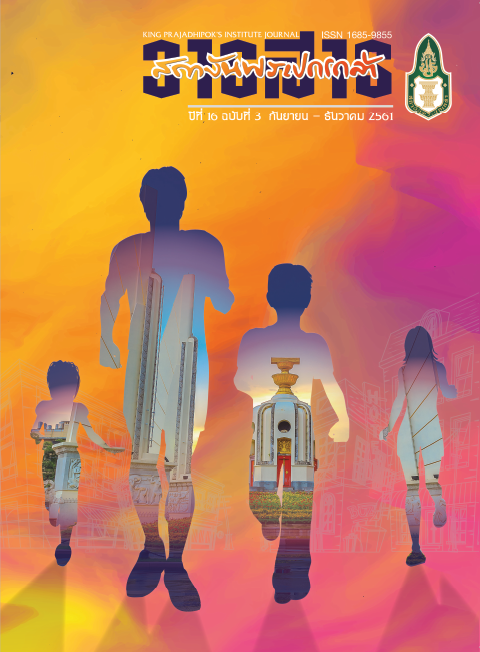Urbanization, Regionalism, and Voting Behavior in Thailand: Spatial Regression Model
Main Article Content
Abstract
There are few evidences on the relationship between political geography and election. This study aims at exploring the relationship between urbanization and latest voting behavior (2011) in Thailand using spatial error regression analysis. Urbanization index has been constructed by principal component analysis, and two components are revealed, namely urban socioeconomic index (USEI) and urban density index (UDI). The study of voting behavior was collected from the Election Commission of Thailand including vote sharing from political parties, the proportion of the people who do not go to polling station to vote and people who choose their right for vote no.
Spatial error regression model was applied in this study. The result shows that the place where USEI and UDI were low tend to vote for Pheuthai party. This was contrary to the Democrat party that gained votes in high Urbanization index and positively relates with the proportion of the people who do not go to polling station and go to choose their right for “ no vote” . Besides, the result has shown that the election in Thailnad is regionalism as flows: Pheuthai Party dominates northeastern region, while Democrat party occupies southern region.
Article Details
@ 2020 King Prajadhipok's Institute The Government Complex Commemorating All Right Reserved.
References
Anselin, L. (2001). Spatial Econometrics. In B. H. Baltagi (Ed.), A Companion to Theoretical Econometrics (pp. 310-330). United States: Blackwell Publishing Ltd.
Darley, J. M., & Latane, B. (1968). Bystander intervention in emergencies: Diffusion of responsibility. Journal of Personality and Social Psychology, 8(4, Pt.1), 377-383. doi:10.1037/h0025589
Downs, A. (1957). An Economic Theory of Political Action in a Democracy. Journal of Political Economy, 65(2), 135-150.
Duell, D., & Valasek, J. M. (2017). Social identity and political polarization: Evidence on the impact of identity on partisan voting trade. Economics of Change. Discussion Papers. Social Science Research Center Berlin (WZB).
H. Hotelling. (1936). Relations Between Two Sets of Variates. Biometrika, 28(3-4), 321-377. doi:10.1093/biomet/28.3-4.321
Hair, J. F., Tatham, R. L., Anderson, R. E., & Black, W. (1995). Multivariate Data Analysis. New Jersey: Prentice-Hall Inc.
Harkins, S. G., & Latané, B. (1998). Population and political participation: A social impact analysis of voter responsibility. Group Dynamics: Theory, Research, and Practice, 2(3), 192-207. doi:10.1037/1089-2699.2.3.192
Hotelling, H. (1933). Analysis of a complex of statistical variables into principal components. Journal of Educational Psychology, 24(6), 417-441. doi:10.1037/h0071325
Kitiarsa, P. (2009). [Review of the book Performing Political Identity: The Democrat Partyin Southern Thailand, by MARC ASKEW. Silkworm Books, 2008]. Suranaree Journal of Social Science, 3(2), 165-168.
Li, Y., Wang, X., Zhu, Q., & Zhao, H. (2014). Assessing the spatial and temporal differences in the impacts of factor allocation and urbanization on urban–rural income disparity in China, 2004–2010. Habitat International, 42, 76-82. doi:10.1016/j.habitatint.2013.10.009
Mehaina, M., El-Bastawissi, I., & Ayad, H. (2016). The Comprehensive Urbanization Level Index (CULI) As A New Approach To Reclassifying Urban And Rural Settlements In Egypt. WIT Transactions on Ecology and the Environment, 204, 12.
Organisation For Economic Co-Operation And Development. (2008). Handbook On Constructing Composite Indicators. In Methodology And User Guide.
Petrişor, A.-I., Ianoş, I., Iurea, D., & V?idianu, M.-N. (2012). Applications of Principal Component Analysis Integrated with GIS. Procedia Environmental Sciences, 14, 247-256. doi:https://doi.org/10.1016/j.proenv.2012.03.024
Roy, J., Perrella, A. M. L., & Borden, J. (2015). Rural, Suburban and Urban Voters: Dissecting Residence Based Voter Cleavages in Provincial Elections. Canadian Political Science Review, 9(1), 112-127.
Taherdoost, H., Sahibuddin, S., & Jalaliyoon, N. (2014). Exploratory Factor Analysis; Concepts and Theory. Paper presented at the Advances in Applied and Pure Mathematics.
Thananithichot, S. (2012). Political engagement and participation of Thai citizens: the rural–urban disparity. Contemporary Politics, 18(1), 87-108. doi:10.1080/13569775.2012.651274
Tobler, W. R. (1970). A Computer Movie Simulating Urban Growth in the Detroit Region. Economic Geography, 46, 234-240. doi:10.2307/143141
United Nations Centre for Human Settlements [Habitat]. (2001). The State of the World’s Cities 2001, Chapter 7. In.
United Nations Development Programme [UNDP]. (2016). Sustainable Urbanization Strategy UNDP’s Support To Sustainable, Inclusive And Resilient Cities In The Developing World. Retrieved from http://www.undp.org/content/dam/undp/library/Sustainable%20Development/Urbanization/UNDP_Urban-Strategy.pdf
Whelan, R. D., & Lidauer, M. (2011). Thailand General Election 3rd July 2011. Retrieved from Bangkok.


